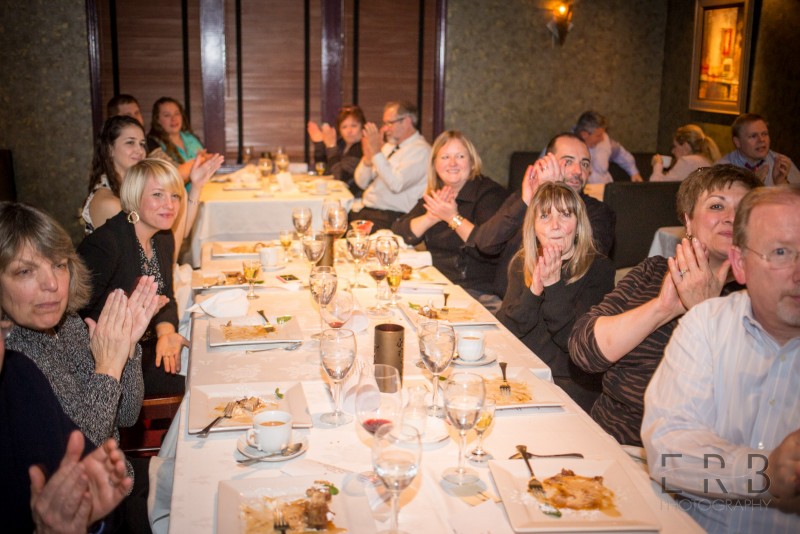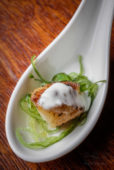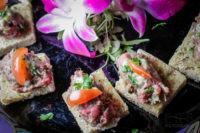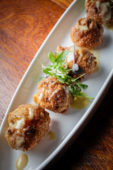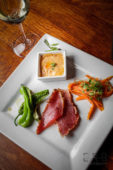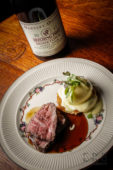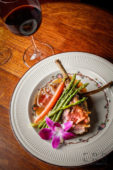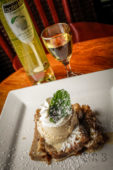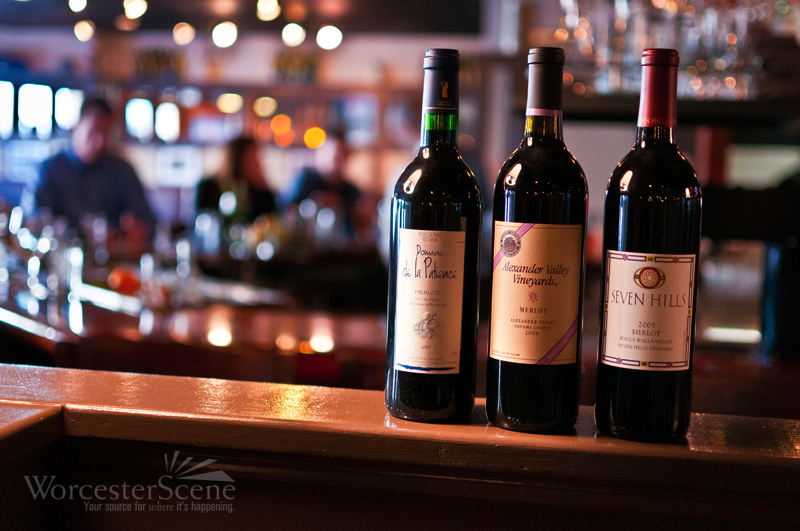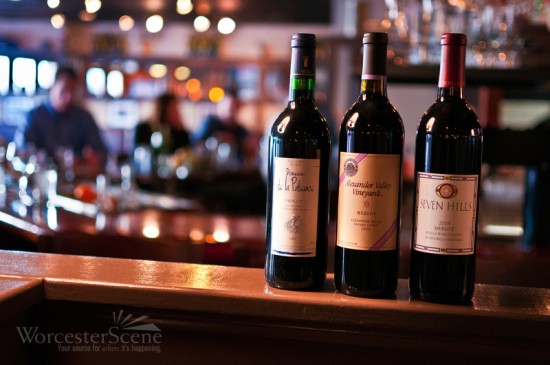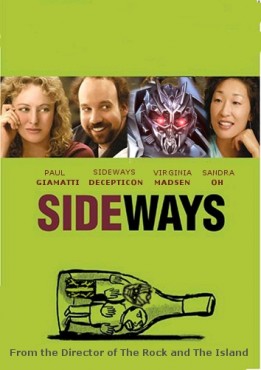
Let me jump to the third course of our third Chef’s Best event featuring Chef Bill Brady’s five-course extravaganza at his restaurant Sonoma, located in Princeton, Mass.
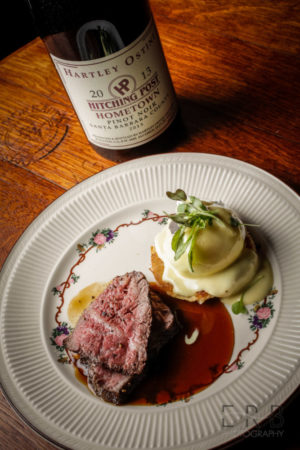
Hartley-Ostini Hitching Post Hometown Pinot Noir was paired with our third course—the Grilled Steak and Egg. The coffee-rubbed Wagyu beef with local porter molasses next to a poached egg in hollandaise sauce on top of a griddled crumpet was a piece of art on the plate. While the meat was the star, we were in the midst of pairing legend.
Chef Bill Brady, who opened Sonoma 20 years ago, informed us that this wasn’t just any Pinot. Hartley-Ostini, the little winery “started as a lark,” according to one of its founders Gray Hartley, was Hollywood famous. Chef Brady told us he put the Pinot Noir on the menu because it’s a great wine and because it’s featured in Alexander Payne’s Academy Award winner, Sideways. The 2004 film is about two friends traveling through Santa Barbara wine country. It’s hard to imagine that only 12 years have passed since we all learned how to, and why we should, appreciate Pinot Noir. And, it’s even harder to imagine a world without the film’s classic mantra, “I’m not drinking any fucking Merlot.”
The movie’s success propelled the winery to stardom, Chef Brady explained. Then he added that he discovered Hartley-Ostini long before Paul Giamatti ever savored a glass. He told us the story like he knew what it meant to wait for your vision to take off and grant you the privilege to do what you love.
When you walk into Sonoma accolades like Open Table’s Diners’ Choice Award 2015 and Top 100 Restaurants in the USA 2015 greet you and lead you to the bar where the event reception was held. A glass of Champy, a sparkling wine from California’s north coast, welcomed us to the party. As we sipped, servers passed first-course treats, which included a foie gras torchon served in push pops, chicken and Andouille beignets, wok-seared bay scallops in wakame and wasabi crème fraiche, and steak tartare crostini.
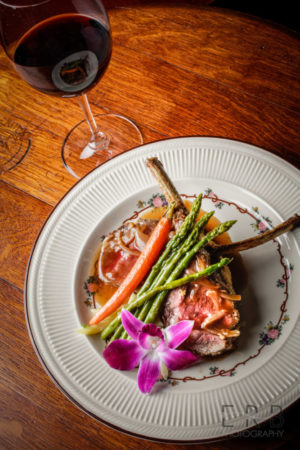
With Chef’s Best, chefs are given creative license to present an out-of-the-ordinary culinary experience to a limited number of guests. It’s an event. Since it’s an event, there’s a palpable sense of anticipation as each course is served and glass is poured. Chef Bill Brady concocted a vision that seemed to highlight his years of expertise, his dedication to quality farm-to-table dining, and his appreciation for the diner.
While he presented a broad range of courses to enjoy, the subtext of each course was that he wanted us to have a phenomenal, and indulgent, feast.
As soon as we sat down, they presented us with the second course, Togarashi Tuna—seared ahi tuna with shishito peppers, pickled carrot salad, and Gochujang, which is a savory, spicy, and pungent fermented Korean condiment made from red chili, glutinous rice, fermented soybeans, and salt. The dish was paired with Ferrari-Carano Bella Luce. Bella Luce, meaning beautiful light in Italian, is a white wine blend with sweet notes of honeydew, pineapple, and vanilla, which helped balance out this spicy dish.
From the tuna we went to the Steak and Eggs (and famous Pinot). And finally we were served the bright spot of the night, the Roast Rack of Lamb Persillade. The two-bone rack of Colorado Lamb coated in Dijon, rosemary, garlic, and parsley then rolled in fresh panko in a roasted demi-glace accompanied a side of mashed potato and a few stalks of asparagus and carrot. Chef Bill Brady explained that there is an excess layer of fat in between the meat and the skin of the lamb. He took that fat, which was then chopped and sautéed, and added it to the mashed potato.
The main course had the comfort of a home-cooked meal and the wine pairing of a Sonoma County vineyard. The Martin Ray Cabernet Sauvignon contributed nicely to the decadence of the lamb with its smooth supple notes of ripe cherry, rich blackberry, and just a hint of spice.
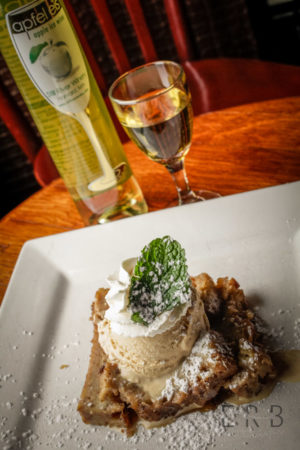
Our fifth and final act of the night brought us to the Banana Pain Perdue, or French toast, with a Salted Carmel Ice Cream and velvety whipped cream on top. Our Apfel Eis Wine came from down the road at Still River Winery in Harvard, Mass. The dessert wine brought our evening to a bittersweet close.
With the third installment of our quarterly Chef’s Best series behind us, patterns have emerged, like each chef is clearly passionate about cooking and dining. Chef Bill Brady stood out as a someone who takes food seriously but doesn’t take himself too seriously. While the dining room at Sonoma is romantic, cozy, and elegant (with incredible acoustics—the place was full but I could only hear murmurs and my conversation), he made everyone feel at home. He even agreed to send his recipes as well as directions to anyone who wanted to recreate our evening. He then joked, “I can’t tell you how much of each ingredient to add, but I’m happy to share my recipes!”
I hope to see you at the next event tentatively scheduled for July. Please considering joining our eNewsletter (in the footer) or follow us on Facebook to see when tickets go on sale.
